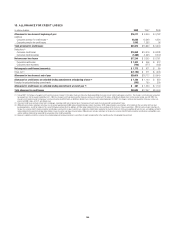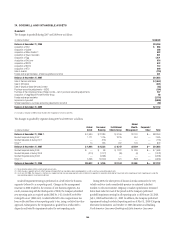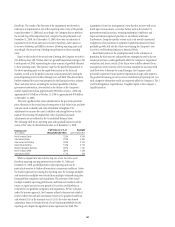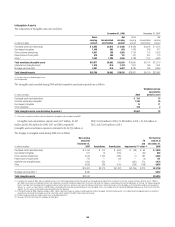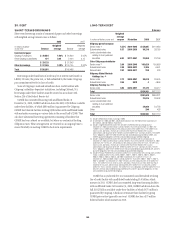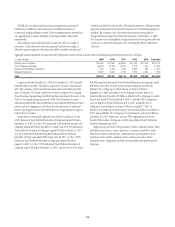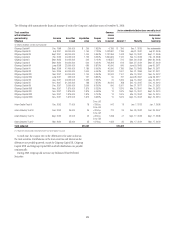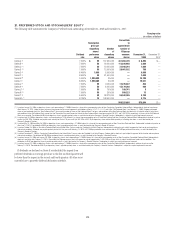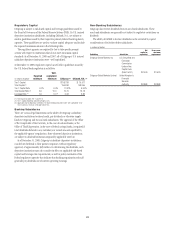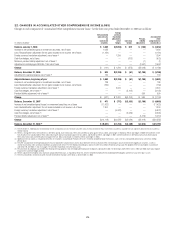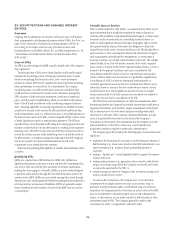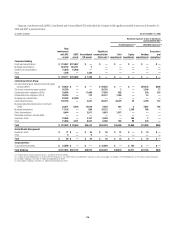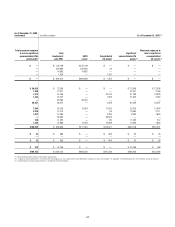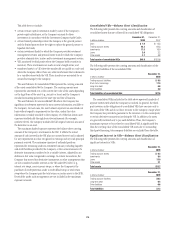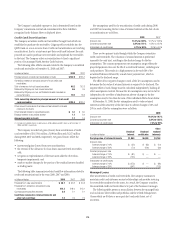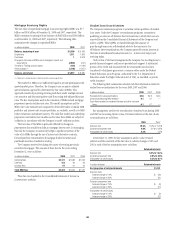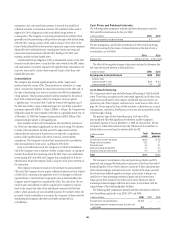Citibank 2008 Annual Report Download - page 181
Download and view the complete annual report
Please find page 181 of the 2008 Citibank annual report below. You can navigate through the pages in the report by either clicking on the pages listed below, or by using the keyword search tool below to find specific information within the annual report.23. SECURITIZATIONS AND VARIABLE INTEREST
ENTITIES
Overview
Citigroup and its subsidiaries are involved with several types of off-balance
sheet arrangements, including special purpose entities (SPEs). See Note 1 on
page 122 for a discussion of proposed accounting changes to SFAS 140,
Accounting for Transfers and Servicing of Financial Assets and
Extinguishments of Liabilities (SFAS 140), and FASB Interpretation No. 46,
“Consolidation of Variable Interest Entities (revised December 2003)
(FIN 46 (R)).”
Uses of SPEs
An SPE is an entity designed to fulfill a specific limited need of the company
that organized it.
The principal uses of SPEs are to obtain liquidity and favorable capital
treatment by securitizing certain of Citigroup’s financial assets, to assist
clients in securitizing their financial assets, and to create investment
products for clients. SPEs may be organized in many legal forms including
trusts, partnerships, or corporations. In a securitization, the company
transferring assets to an SPE converts those assets into cash before they
would have been realized in the normal course of business, through the
SPE’s issuance of debt and equity instruments, certificates, commercial
paper, and other notes of indebtedness, which are recorded on the balance
sheet of the SPE and not reflected on the transferring company’s balance
sheet, assuming applicable accounting requirements are satisfied. Investors
usually have recourse to the assets in the SPE and often benefit from other
credit enhancements, such as a collateral account or overcollateralization in
the form of excess assets in the SPE, or from a liquidity facility, such as a line
of credit, liquidity put option or asset purchase agreement. The SPE can
typically obtain a more favorable credit rating from rating agencies than the
transferor could obtain for its own debt issuances, resulting in less expensive
financing costs. The SPE may also enter into derivative contracts in order to
convert the yield or currency of the underlying assets to match the needs of
the SPE investors, or to limit or change the credit risk of the SPE. Citigroup
may be the provider of certain credit enhancements as well as the
counterparty to any related derivative contracts.
SPEs may be Qualifying SPEs (QSPEs) or Variable Interest Entities (VIEs)
or neither.
Qualifying SPEs
QSPEs are a special class of SPEs defined in (SFAS 140). QSPEs have
significant limitations on the types of assets and derivative instruments they
may own or enter into and the types and extent of activities and decision-
making they may engage in. Generally, QSPEs are passive entities designed
to purchase assets and pass through the cash flows from those assets to the
investors in the QSPE. QSPEs may not actively manage their assets through
discretionary sales and are generally limited to making decisions inherent in
servicing activities and issuance of liabilities. QSPEs are generally exempt
from consolidation by the transferor of assets to the QSPE and any investor
or counterparty.
Variable Interest Entities
VIEs are entities defined in (FIN 46(R)), as entities that have either a total
equity investment that is insufficient to permit the entity to finance its
activities without additional subordinated financial support or whose equity
investors lack the characteristics of a controlling financial interest (i.e.,
ability to make significant decisions through voting rights, right to receive
the expected residual returns of the entity and obligation to absorb the
expected losses of the entity). Investors that finance the VIE through debt or
equity interests or other counterparties that provide other forms of support,
such as guarantees, subordinated fee arrangements, or certain types of
derivative contracts, are variable interest holders in the entity. The variable
interest holder, if any, that will absorb a majority of the entity’s expected
losses, receive a majority of the entity’s expected residual returns, or both, is
deemed to be the primary beneficiary and must consolidate the VIE.
Consolidation under FIN 46(R) is based on expected losses and residual
returns, which consider various scenarios on a probability-weighted basis.
Consolidation of a VIE is, therefore, determined based primarily on
variability generated in scenarios that are considered most likely to occur,
rather than based on scenarios that are considered more remote. Certain
variable interests may absorb significant amounts of losses or residual
returns contractually, but if those scenarios are considered very unlikely to
occur, they may not lead to consolidation of the VIE.
All of these facts and circumstances are taken into consideration when
determining whether the Company has variable interests that would deem it
the primary beneficiary and, therefore, require consolidation of the related
VIE or otherwise rise to the level where disclosure would provide useful
information to the users of the Company’s financial statements. In some
cases, it is qualitatively clear based on the extent of the Company’s
involvement or the seniority of its investments that the Company is not the
primary beneficiary of the VIE. In other cases, a more detailed and
quantitative analysis is required to make such a determination.
The Company generally considers the following types of involvement to be
significant:
• assisting in the structuring of a transaction and retaining any amount of
debt financing (e.g., loans, notes, bonds or other debt instruments) or an
equity investment (e.g., common shares, partnership interests or
warrants);
• writing a “liquidity put” or other liquidity facility to support the issuance
of short-term notes;
• writing credit protection (e.g., guarantees, letters of credit, credit default
swaps or total return swaps where the Company receives the total return
or risk on the assets held by the VIE); or
• certain transactions where the Company is the investment manager and
receives variable fees for services.
In various other transactions, the Company may act as a derivative
counterparty (for example, interest rate swap, cross-currency swap, or
purchaser of credit protection under a credit default swap or total return
swap where the Company pays the total return on certain assets to the SPE);
may act as underwriter or placement agent; may provide administrative,
trustee, or other services; or may make a market in debt securities or other
instruments issued by VIEs. The Company generally considers such
involvement, by itself, “not significant” under FIN 46(R).
175


